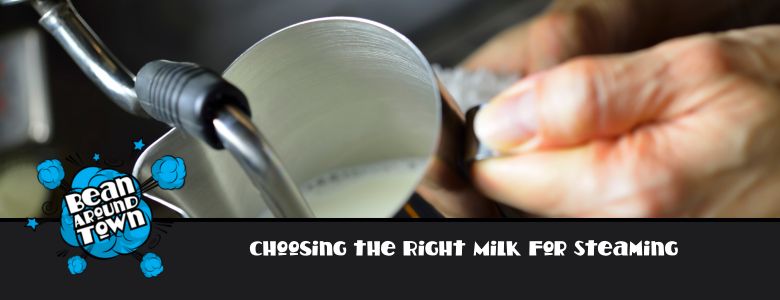Want to improve your coffee-making skills? It all comes down to how you steam milk! In this guide, we’ll cover how to steam milk properly, the difference between steaming and frothing, the correct temperature, and even how to make latte art.
Key Takeaways
- Steamed milk creates a velvety milk texture, while frothed milk increases in volume with more foam.
- The ideal steaming temperature ranges from 55°C–65°C to avoid bitterness and ensure a creamy texture.
- You can still produce frothy milk without a steam wand by using a jar or whisk, though a steam wand gives better results.
Table of Contents
Steamed Milk vs Frothed Milk: What’s the Difference?
Before you start steaming, it’s important to know the difference between steamed milk and frothed milk.
- Steamed milk has a creamy texture with small bubbles, giving it a velvety milk consistency—perfect for a latte or flat white.
- Frothed milk, on the other hand, is airy and light, with a thick layer of milk foam, ideal for a cappuccino.
The way you use the steam wand changes the outcome:
- For a latte, keep the tip of the steam wand just under the surface of the milk for 1–3 seconds to create small bubbles and a creamy texture.
- For a cappuccino, introduce more air bubbles by keeping the wand near the surface for 6–8 seconds to build frothy milk foam.
The secret to perfect steamed milk is how the milk spins in the milk jug—a whirlpool motion helps break up large bubbles and creates a smooth, rich texture.
The Correct Temperature for Steaming Milk
Heating milk to the correct temperature is key to achieving the best taste and texture.
- Too hot? The milk warms past 70°C and starts to burn, giving your coffee drink a bitter taste.
- Too cold? The milk won’t develop the right volume or creamy texture.
- The sweet spot? Between 55°C–65°C for cow’s milk and around 55°C–60°C for plant-based milk.
A simple trick? Feel the milk jug. If it’s too hot to touch, it’s overheated! Stop steaming when it’s warm but still comfortable to hold.

Step-by-Step Guide to Steaming Milk with a Steam Wand
Using a steam wand might seem tricky, but with practice, you’ll get perfect steamed milk every time!
1. Prepare Your Milk Jug
Start by filling your milk jug about one-third full—remember, cold milk expands as it heats. Whole milk is the best option for a creamy texture and naturally sweet flavour, though you can use alternatives like oat or soy milk. A stainless steel milk jug helps control heat more effectively, making it easier to achieve the perfect consistency.
2. Position the Steam Wand Correctly
Place the tip of the steam wand just below the surface of the milk, ensuring proper air incorporation. You should hear a gentle hissing sound, which means air is mixing into the milk.
Keep the jug at a slight angle so the milk spins, creating a whirlpool effect. This movement helps distribute heat evenly and form smooth, velvety milk foam without large bubbles.
3. Heat and Froth the Milk
As the milk warms, gradually lower the steam wand deeper into the jug to blend the bubbles smoothly. Pay close attention to the temperature—when the jug feels hot but not burning to the touch, it’s time to turn off the steam wand.
To finish, tap the jug gently on the bench to remove any remaining large air bubbles and swirl it for a silky texture. Now you have perfect steamed milk and are ready to elevate your coffee drink!
Creating Latte Art with Steamed Milk
Want to take your coffee drink to the next level? Try latte art! Follow these simple steps to create beautiful designs in your cup:
- Brew a fresh shot of espresso and pour it into your cup. Swirl the cup gently to mix the crema evenly.
- Steam your milk to create smooth, velvety microfoam. Tap the milk jug on the bench to remove large bubbles and swirl it to keep the texture even.
- Hold the milk jug about 5cm above the coffee and pour slowly in a thin stream, letting the milk mix smoothly with the espresso.
- As the cup fills, bring the jug closer to the surface and tilt it slightly to start forming a design.
- For a heart shape, gently move the jug side to side, then pull the pour through the centre to finish.
- For more complex designs like rosettas, pour steadily while wiggling the jug slightly and finishing with a quick pull-through.
- Practice regularly—great latte art takes time, but the better your steamed milk, the easier it becomes!

Choosing the Right Milk for Steaming
Not all milk steams the same way. Here’s a guide to the best milk options:
- Whole milk – Creates the best creamy texture and sweet flavour.
- Oat milk – Froths well, especially barista blends.
- Soy milk – Forms a thick milk foam, but some brands curdle with heat.
- Almond milk – Can work, but barista blends are better.
- Coconut milk – High in fat, creating rich foam.
No matter what milk you choose, using a stainless steel milk jug makes steaming easier.
Enhancing Your Coffee Experience
There’s something truly satisfying about steaming milk—the gentle hiss of the steam wand in your espresso machine, the way the milk spins and transforms into a velvety, creamy texture, and the rich, sweet flavour it adds to your coffee. It’s not just a technique; it’s an experience.
Take a moment to appreciate the process. Feel the warmth of the milk jug, watch as small bubbles form and create that perfect milk foam, and enjoy the way a great cup of coffee comes together. Whether you’re making a silky latte or a frothy cappuccino, steaming milk is where science meets art.
Summary
Mastering how to steam milk is the secret to making great coffee at home. The right technique, correct temperature, and milk texture all play a role in creating perfect steamed milk for your latte, cappuccino, or any other coffee drink.
Like any skill, it takes time—but once you learn how to create the right whirlpool effect and manage the air bubbles, you’ll be steaming velvety milk like a pro.
So get your jug, heat up some cold milk, and start experimenting. Soon, your espresso drinks will taste as good as the ones from well-known brands!
Frequently Asked Questions
What is the ideal temperature for steaming milk?
For the best results, aim for 55°C to 65°C when steaming milk. This gives it a smooth, velvety texture without scalding it. Too hot, and it can taste burnt. Too cold, and it won’t be creamy enough for your coffee!
Can I steam milk without a steam wand?
Yes, you can! If you don’t have a steam wand, just heat your milk in the microwave until warm (not boiling), then shake it in a jar or whisk it vigorously to create froth. It won’t be quite the same as a coffee machine, but it still works for a delicious homemade coffee!
What type of milk is best for steaming?
Whole milk is the best choice because its higher fat content creates a creamier texture and better froth. If you prefer non-dairy options, oat milk and soy milk are great choices—they froth well and add a nice flavour to your coffee.
How can I create latte art at home?
You don’t need to be a pro to make latte art! Just steam your milk until it’s smooth with a bit of foam, then pour it steadily into your espresso. Start with a simple heart shape—just pour in the centre, wiggle the jug slightly, and finish with a pull-through. With practice, you’ll get better at creating beautiful patterns!
Why does my steamed milk taste bitter?
If your steamed milk tastes bitter, it’s probably too hot. Keep the temperature between 55°C and 65°C to avoid scalding it. Overheating breaks down the milk proteins and fats, making it taste burnt instead of smooth and creamy.






